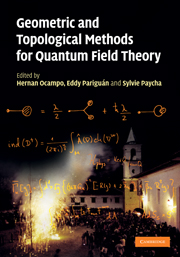Book contents
- Frontmatter
- Contents
- List of contributors
- Introduction
- 1 The impact of QFT on low-dimensional topology
- 2 Differential equations aspects of quantum cohomology
- 3 Index theory and groupoids
- 4 Renormalization Hopf algebras and combinatorial groups
- 5 BRS invariance for massive boson fields
- 6 Large-N field theories and geometry
- 7 Functional renormalization group equations, asymptotic safety, and quantum Einstein gravity
- 8 When is a differentiable manifold the boundary of an orbifold?
- 9 Canonical group quantization, rotation generators, and quantum indistinguishability
- 10 Conserved currents in Kähler manifolds
- 11 A symmetrized canonical determinant on odd-class pseudodifferential operators
- 12 Some remarks about cosymplectic metrics on maximal flag manifolds
- 13 Heisenberg modules over real multiplication noncommutative tori and related algebraic structures
6 - Large-N field theories and geometry
Published online by Cambridge University Press: 07 September 2010
- Frontmatter
- Contents
- List of contributors
- Introduction
- 1 The impact of QFT on low-dimensional topology
- 2 Differential equations aspects of quantum cohomology
- 3 Index theory and groupoids
- 4 Renormalization Hopf algebras and combinatorial groups
- 5 BRS invariance for massive boson fields
- 6 Large-N field theories and geometry
- 7 Functional renormalization group equations, asymptotic safety, and quantum Einstein gravity
- 8 When is a differentiable manifold the boundary of an orbifold?
- 9 Canonical group quantization, rotation generators, and quantum indistinguishability
- 10 Conserved currents in Kähler manifolds
- 11 A symmetrized canonical determinant on odd-class pseudodifferential operators
- 12 Some remarks about cosymplectic metrics on maximal flag manifolds
- 13 Heisenberg modules over real multiplication noncommutative tori and related algebraic structures
Summary
Abstract
This is a short introduction to the ideas of the AdS/CFT correspondence. In order to be self-contained, the chapter includes an introduction to the study of strings as geometric objects moving in spacetime and in particular their solvability in flat space. I also mention why strings give rise to a theory of gravity. D-branes are introduced as a collection of geometric objects where strings can end. The low-energy dynamics of a collection of D-branes is explored in two different ways, and this serves as a basis for a formulation of the AdS/CFT correspondence: an equivalence between a gravitational formulation of the dynamics and a gauge theory description. The problem of how to compare observables between the two formulations is presented, and some basic aspects of the representation theory of the superconformal group are explored, so that one can have tests of the AdS/CFT proposal.
Introduction
Roughly ten years ago, the AdS/CFT correspondence was formulated by Maldacena [20]. In its simplest example, the AdS/CFT correspondence states that a certain four-dimensional quantum field theory that is made from gauge fields and some matter content – a theory similar to the theory of strong, weak or electromagnetic interactions – is equivalent as quantum theory to type IIB string theory (as a theory of quantum gravity) on spacetimes that are asymptotic to a particular classical solution of type IIB string theory, namely AdS5 × S5.
This correspondence has not been proved. This is in great part because we do not know what quantum gravity is.
- Type
- Chapter
- Information
- Geometric and Topological Methods for Quantum Field Theory , pp. 253 - 287Publisher: Cambridge University PressPrint publication year: 2010



